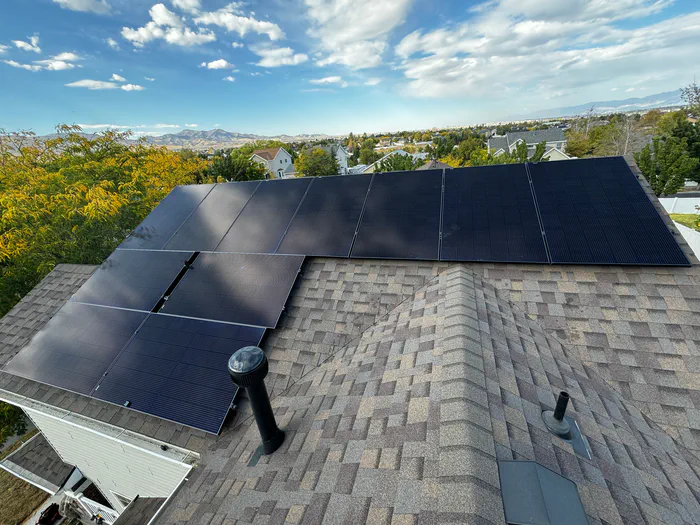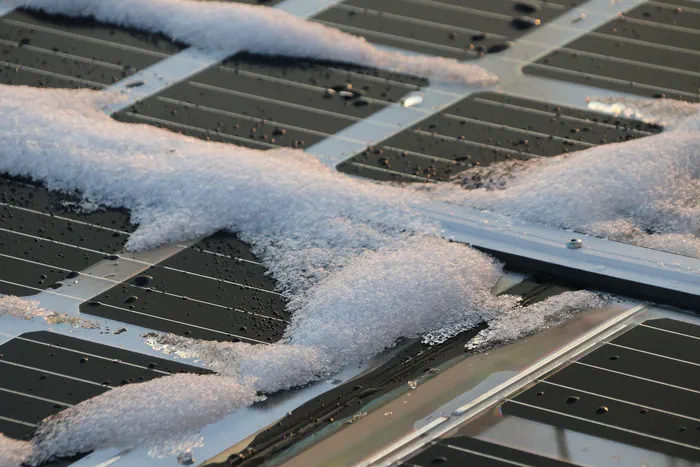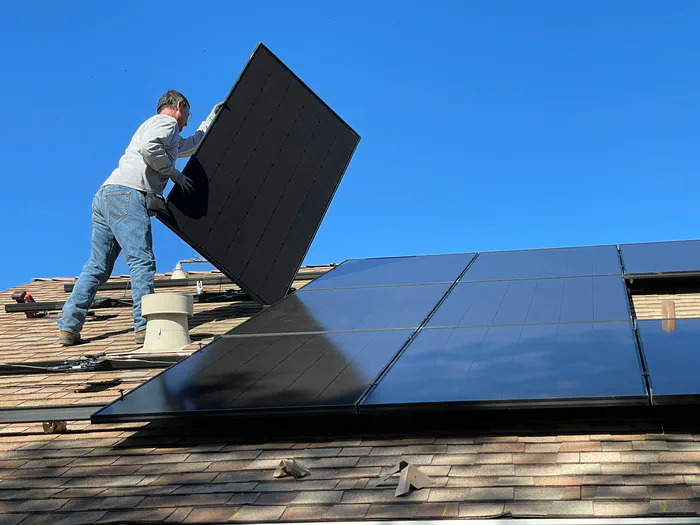With grey skies, snowfall, and a lot of cloudy weather during winter, who would expect solar panels to generate power when the sun barely shows up, right?
The reality is, solar panels do work in winter. In fact, many states in the northern U.S. that experience harsh winters are actually among the top states for solar power.
Read further as we discuss how much less energy you can expect from your solar panels in winter and why this seasonal dip isn’t a major issue. We’ve also outlined practical tips to help you maximize your panels’ production during the cold season.
Do Solar Panels Work in Winter?
Yes, solar panels work in winter. While shorter daylight hours and heavy snow can definitely affect energy production, winter conditions don’t stop solar panels from generating electricity.
Here’s where people often get it wrong: They assume solar panels generate energy from heat – something that’s abundant during the blazing summer days but seemingly absent during the cold winter months…
But solar panels do not produce energy from heat. Instead, they generate energy from sunlight through a process called the photovoltaic effect, where sunlight photons excite electrons in the solar cells.
So, as long as sunlight – despite being “weaker” during the winter months – reaches your solar panels, they’ll continue to generate electricity.
Do Solar Panels Work When Covered in Snow?
Yes, solar panels still work when covered in snow, since sunlight can still be absorbed in parts that are exposed and remain unobstructed. Moreover, snow can actually help with energy production as it can reflect sunlight to your panels via the albedo effect.
If you’re concerned about snow accumulation, know that it’s rarely an issue for well-angled roofs. The slope allows the snow to naturally slide off your panels.
For light or powdery snow, it often blows away or melts quickly once the sun comes out.
However, heavy snow that completely covers the panels (more common on low-pitched roofs) can block sunlight and temporarily halt electricity production. Instead of waiting for it to melt, you can take matters into your own hands and use a solar panel snow rake to remove the snow safely.
How Efficient Are Solar Panels in the Winter?
Solar panels are just as efficient in winter as they are in other seasons. In fact, cold weather can actually help your panels become more efficient. How so?
Cold weather doesn’t cause any kind of heat loss. In fact, solar panels are designed to withstand extreme temperatures as low as –40°F, and at these colder temperatures, the panels can perform at or near their peak efficiency.
Now let’s look at the polar opposite. In hot weather, the temperature rise causes the electrical resistance within the panels to increase. The higher this resistance gets, the harder it becomes for them to convert sunlight into energy.
This is why summer heat, especially in regions with intense sun exposure, can slightly degrade panel performance.
Solar panels are typically rated for optimal performance at 77°F. For each degree Celsius (or about 1.8°F) above this temperature, their efficiency drops by a small percentage.
This drop is referred to as the temperature coefficient and ranges from -0.3% to 0.5% per degree Celsius, depending on the brand and model.
With that said, don’t confuse “efficiency” with “energy production”. Your solar panels may be more efficient at converting sunlight into energy during the winter, but their overall energy production is likely to be lower this season.
How Much Less Energy Do Solar Panels Produce in Winter?
Generally, you can expect your solar panels to produce 30 to 55 percent less in winter compared to summer days, though the difference can at times be greater.
This happens because naturally, winter brings fewer daylight hours and more cloudy or overcast days, reducing the sunlight your panels can absorb.
Let’s put that into perspective.
Climate data for Minnesota shows there are about 114 sunshine hours in December compared to 350 hours in July. If you have a 5 kW solar system, your system could generate:
- In peak summer (July): 5 kW x 350 hours = 1,750 kWh
- In peak winter (Dec): 5 kW x 114 hours = 570 kWh
This shows a 67% reduction in energy output.
Now, the difference might seem stark, but it’s not unchangeable. And there are definitely a few steps you can take to minimize this gap and improve your solar system’s winter production.
How to Maximize Solar Panel Production During Winter
You can’t control how much sunlight reaches your panels or stop clouds from covering the sky. But there are still ways for you to maximize energy production and get closer to meeting your energy needs during winter. Here’s a list of these practical tips.
Remove Accumulated Snow on Your Panels
As discussed, heavy snow can occasionally pile up and completely cover your panels. This not only reduces energy production but can also add unnecessary structural stress to the panels and their mounting system.
To safely clear the snow, use a solar panel snow rake to brush off any stubborn buildup. Avoid shovels, metal tools, or other heavy or sharp equipment, as they can scratch or damage the surface of your panels.
This is fairly easy to do if you have a ground-mounted system since it’s more accessible. But if your panels are roof-mounted, take extra caution when attempting to clear the snow.
Adjust the Tilt of Your Panels
The farther you are from the equator, the lower the sun sits in the sky during winter. Adjusting your panels’ tilt compensates for the lower sun angle, allowing more sunlight to hit the panel surface.
The general rule is to increase the panel tilt by 15° from your latitude. For example, if you live in Michigan at 44° latitude, the winter tilt angle would be approximately 59° (44° + 15°).
For this, single-axis or dual-axis tracking systems can automatically adjust your panels’ angle and orientation to follow the sun’s path throughout the day and year.
However, most residential solar panels are fixed-mount. If a professional solar installer sets up your system, your panels should already be positioned at an optimal year-round angle to maintain efficient performance through all seasons.
Invest in Solar Batteries
Solar batteries store energy for later use, which allows you to take advantage of peak and off-peak electricity hours. Here’s how it works…
During daytime, your solar panels generate some energy, which the battery stores.
With some storage space left, you charge and top up your battery using grid electricity during off-peak hours when rates are lower, usually at night.
Later, when electricity rates rise during peak hours (typically in the morning and early evening), you can draw stored power from your battery instead of relying on expensive grid energy.
This cycle not only saves you money but also ensures your home has a consistent power supply, especially when winter sunlight is limited.
Although, keep in mind that solar batteries can lose efficiency in extreme cold. Make sure to store them in a location where temperatures stay within the manufacturer’s recommended range to prevent performance drops and extend their lifespan.
Is it Worth Installing Solar Panels in Cold Climates?
Yes, installing solar panels in cold climates is definitely worth it. In fact, northern states, such as Minnesota, Massachusetts, and New York rank among the top 20 for solar power generation, according to SEIA data.
And although energy production may dip in winter, this is less of a concern when you consider solar energy that you can generate over the entire year.
During the summer months, with more sunlight, you can take advantage of net metering and Solar Renewable Energy Certificates (SRECs). These programs allow you to either earn energy credits or tangible income by selling excess power, helping you offset the energy shortfall in winter.
Year-Round Solar Savings Start With the Right Design
With the right planning, installation, and upkeep, your home’s solar system can continue delivering energy savings, even in the coldest climates.
Quote for Solar helps you easily connect with trusted solar installers who we‘ve personally screened to ensure they can create an optimal system for year-round performance.
Simply request a quote today, and we’ll provide you with three competitive quotes from top-rated solar installers in your area, so you can start benefiting from solar energy right away.
If you found this article helpful, please share it with your friends and family, and don’t forget to subscribe to our blog for more informative content on solar energy and sustainability!




